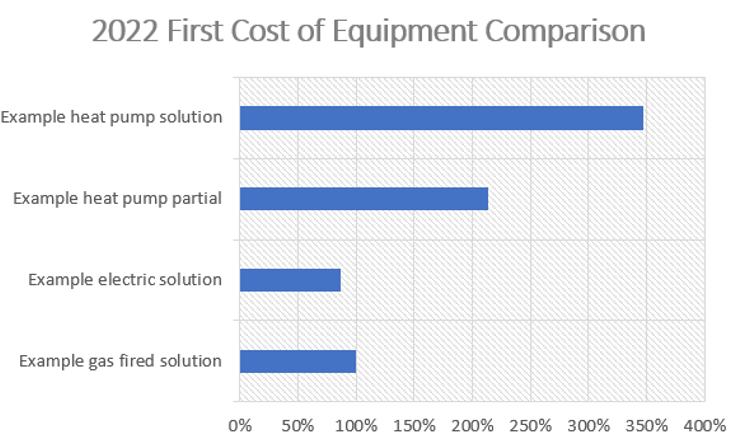 Your client is interested in a commercial R-744 refrigerant heat pump water heater solution. The example system I used in this blog is an apartment building in Ann Arbor, Michigan where there is no legislative command to stop using gas fired water heaters. What is the first cost impact and life cycle cost rewards for the heat pump solution vs. the gas or electric solution?
Your client is interested in a commercial R-744 refrigerant heat pump water heater solution. The example system I used in this blog is an apartment building in Ann Arbor, Michigan where there is no legislative command to stop using gas fired water heaters. What is the first cost impact and life cycle cost rewards for the heat pump solution vs. the gas or electric solution?
The Example Apartment Building (See Part 9)
In Ann Arbor Michigan, the architect and engineer are asked to design a 4-story apartment building with a total of one hundred units expecting to serve 215 people. Each apartment has a kitchen with dishwasher, a single bathroom with a private low flow shower. Each apartment also has a washing machine. There is a handful of other hot water fixtures. We expect each floor to have four hot water supply lines and the recirculation rate from each loop will be about 0.75 GPM.
The equipment required is summarized here:
| Gas fired solution: | (3) 130-gallon tank heaters with 700,000 BTUH input each. |
| Electric solution: | (3) 119-gallon tank heaters with 216 kW input each |
| Heat pump solution: | (2) Roof mounted 239 – 549 MBH heat pump water heaters with (4) 250-gallon tanks with backup heaters and (2) heat exchanger packages mounted in the mechanical room. |
Just a quick look at the number of pieces of equipment needed will lead you to the first cost gap.
First Cost Differences
It is always a challenge to place a price on a product without a complete understanding of the options required and engineer’s standard specifications. Here is a clear chart showing the sizable equipment cost investment in the R-744 heat pump water heater for northern climates.
So how does this look in 2022 dollars? The gas fired solution equipment could be priced around $150,000 in the Ann Arbor area. Based on that you can see the heat pump solution with all the trim will quote at over ½ million dollars. The story looks gloomy unless you include the operating cost as shown below. The “partial” solution is a teaser and will be introduced next week.
Installation comments:
The gas fired solution includes code approved venting material. The gas fired installation must also include the venting installation and gas piping. The electric resistance solution does not require venting material but will require more electrical labor and electrical disconnect for the heavy kW load. The plumbing piping of the electrical solution and gas fired solutions are similar.
The heat pump solution will require the installation of the heat pump on the roof. There would be a significant reduction in installation costs if the heat pumps were located on grade. There will be a glycol loop required from the heat pumps to the heat exchanger package. The pumps and tanks are included in the packages, The domestic water storage tanks and heat exchanger packages will be mounted and piped in the mechanical room. The piping between the tanks is different for the heat pumps than for the gas or electric solution but close enough in cost to budget close to the same.
Since the heat pump backup uses electric resistance heaters, there will be similar electrical requirements to the electric solution.
First equipment costs and labor costs for the heat pump solution will be significantly more than the gas or electric resistance units. But read on.
Lifetime Operating Energy and Costs
The benefit of the heat pump water heater is in the high coefficient of performance (COP). When I looked at operating costs, I chose to use ASHRAE Systems Handbook chapter 50. The amount of water used in an apartment building is subject to the habits of the people in the building. I used 6400 gallons per day for this 100-apartment example. This is from the average amount used per day for the medium use occupants shown on table 7 of the referenced chapter. I created a spreadsheet which we can use with our Michigan and Ohio engineers and contractors for adjustments.
I also used the ASHRAE BIN data shown in last week’s blog, for weather in Ann Arbor, Michigan. The heat pump solution used only 30% of that used by the electric resistance solution. A significant savings in energy and the carbon producing products used to produce that energy.
There is also the concern about electric utility capacity as more buildings become electrified. There may be significant increases in the cost of electricity. The payback chart shown below uses that concept of an inflation or penalty in electric utility rates. There are many more knowledgeable people in our industry, and I am sure they will voice any corrections needed. That said, here is my chart.
Equipment ROI – Not Including Installation
| Penalty or Inflation Multiplier | Simple Payback in Years |
| 0% | 9 |
| 4% | 8 |
| 5% | 7.7 |
| 6% | 7.4 |
Unless your client simply wants to try something new, the numbers can be tough to justify. I did not include any potential utility rebates or assistance. The COP advantage of the heat pump solution would surely be a great discussion point with the utility and a possible source of custom incentive rebates. Next week I will give you some something to consider in what I am calling the “partial” Heat Pump Solution.
What is Compelling Your Client to Think Decarbonization?
How your client looks at decarbonization as well as the building life will help identify the discussion points prior to spending any money in the design. Is the client compelled by code or local requirements? Is the client and early adopter of innovative technology? Does the company expect to show leadership in innovation and market their decarbonization platform? Will the client own the building for 20 or more years?
Is there a concern by the client about the “social cost” of carbon? Are carbon producing water heaters adding heat which then increases the cost of air conditioning? What healthcare concerns are growing due to the changing environment?
The answer to these questions will help you advise the owner and developer of the viable options on the road to decarbonization.
Part 1: Heat Pump Water Heaters: The Road to Decarbonization
Part 2: Heat Pump Water Heaters: How They Work
Part 3: Heat Pump Water Heaters: Refrigerants and Weather
Part 4: Heat Pump Water Heaters: Temperatures & Storage
Part 5: Heat Pump Water Heaters: Parts & Pieces & Storage
Part 6: Heat Pump Water Heaters: Hot Water Recirculation
Part 7: Heat Pump Water Heaters: Standby Capacity
Part 8: Heat Pump Water Heaters: Capacity, COP, and Weather


